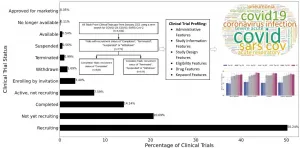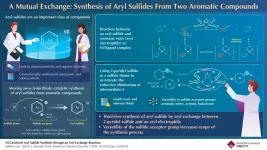(Press-News.org) TORONTO, ON - Researchers at the University of Toronto have developed an innovative tool to aid in the investigation of how we perceive and remember visual experiences.
The new tool, referred to as a "scene wheel," will help researchers study how accurately we construct mental representations of visual experiences for later retrieval -- for example, how well an eyewitness recalls details of a crime or accident.
"We know that eyewitness testimony is not reliable," says Gaeun Son. "With the new scene wheel, we can start to characterize the specific nature of those memory failures."
Son is a PhD student in the Faculty of Arts & Science's Department of Psychology and lead author of a paper published in Behavior Research Methods that describes the scene wheel methodology.
"Studying how people perceive and remember the world requires careful control of the physical stimuli presented in experiments," says Michael Mack. "This kind of control isn't difficult in experiments using simple stimuli like colour. But it's very challenging for more complex, realistic scenes."
Mack and Dirk Bernhardt-Walther are both professors of psychology in the department and co-authors of the study.
Traditional experiments in this field involve test subjects performing tasks such as identifying which colour or which arrangement of graphic symbols most resembles a previously viewed colour or graphic. While these methods provide some insight, their simplicity imposes a fundamental limit to what they can reveal.
The scene wheel moves into a whole new experimental realm by using highly realistic images that more closely simulate our day-to-day visual experiences -- while still providing the rigorous control needed.
The wheel is a continuous, looping series of gradually changing images depicting typical domestic spaces: dining rooms, living rooms and bedrooms. The images are detailed and realistic, and vary continuously in subtle ways: tables subtly transform into desks, mirrors become framed pictures, walls become windows, etc.
The collaborators used deep-learning methods in computer vision -- specifically, generative adversarial networks (GAN) -- to create the images and arrange them in a continuous "spectrum" analogous to a 360-degree colour wheel.
"The success of this project is all thanks to the recent revolution in deep-learning fields," says Son. "Especially in GANs which is the same sort of approach used in creating so-called 'deep fake' videos in which one person's face is very realistically replaced with someone else's."
To test whether their approach worked, the researchers had subjects view a still image of a scene from the wheel for one second, followed by a blank screen. Next, the subjects were presented with a scene similar to the one they just viewed.
The subjects then altered the second image by moving their cursor in a circle around it. As they moved their cursor, the scene changed. Subjects were asked to stop their cursor when the image matched their memory of the original image.
"With the scene wheel, we've provided a new experimental bridge that brings more of the richness of everyday experience into a controlled experimental setting," says Son. "We anticipate that our method will allow researchers to test the validity of classic findings in the field that are based on experiments using simple stimuli."
What's more, the approach could lead to different applications. For example, it could potentially lead to a wheel that uses faces instead of rooms. Such a "face wheel" could take the place of police lineups which are not particularly reliable in identifying individuals.
Says Mack, "Our method will allow for a better understanding of how precise that identification of individuals actually is."
INFORMATION:
The research was supported by Natural Sciences and Engineering Research Council (NSERC) Discovery Grants, the Canada Foundation for Innovation and the Ontario Research Fund.
Note to editors: For a demonstration of the scene wheel, visit the Mack Lab website at https://macklab.github.io/sceneWheel_main/demo.html.
MEDIA CONTACTS:
Gaeun Son
Department of Psychology
Faculty of Arts & Science
University of Toronto
gaeun.son@mail.utoronto.ca
Michael Mack
Department of Psychology
Faculty of Arts & Science
University of Toronto
michael.mack@utoronto.ca
Sean Bettam
Communications & Public Affairs
Faculty of Arts & Science
University of Toronto
s.bettam@utoronto.ca
A new study from Oregon State University found that infants born within 3 kilometers of oil and natural gas drilling facilities in Texas had slightly lower birthweights than those born before drilling began in their vicinity.
The study, published today in the journal Environmental Health Perspectives, found that the type of drilling or resource being extracted did not change the result.
"Most studies to date focus exclusively on unconventional natural gas drilling, or fracking. That particular process is a small subset of the oil and natural gas industry. ...
In order to win the battle against COVID-19, studies to develop vaccines, drugs, devices and re-purposed drugs are urgently needed. Randomized clinical trials are used to provide evidence of safety and efficacy as well as to better understand this novel and evolving virus. As of July 15, more than 6,180 COVID-19 clinical trials have been registered through ClinicalTrials.gov, the national registry and database for privately and publicly funded clinical studies conducted around the world. Knowing which ones are likely to succeed is imperative.
Researchers from Florida Atlantic University's College of Engineering and Computer Science are the first to model COVID-19 completion versus cessation in clinical trials using machine learning algorithms and ensemble learning. The study, ...
Scientists at St. Jude Children's Research Hospital have found a link between post-cancer treatment frailty and neurocognitive decline in young adult childhood cancer survivors. A paper on this work was published today in the Journal of Clinical Oncology.
Though frailty is often associated with the elderly, 8% of young adult childhood cancer survivors meet the criteria for frailty. This study confirms that those who undergo childhood cancer treatment can experience frailty, which can create an early onset of neurocognitive decline in young adults. This study will help with further research to prevent such neurocognitive decline.
"We ...
To reach the target of carbon neutral, a transition from fossil energy to renewable energy generation is indispensable. Photovoltaic technology is considered as one of the most prominent sources of renewable energy. For decades, about 90% of global solar cell market has been dominated by silicon solar cells. Although the price of silicon solar panels decreases year by year, it is a big challenge to significantly reduce its manufacturing cost further. Hence, next-generation photovoltaic technologies are in urgent need of new materials and novel techniques. Recently, metal halide perovskite solar cells (PSCs) have attracted extensive attention from both academia and industry, due to their excellent photoelectric conversion efficiency and great commercial potential.
Metal halide perovskite ...
One of the major challenges in modern cancer therapy is the adaptive response of cancer cells to targeted therapies: initially, these therapies are very often effective, then adaptive resistance occurs, allowing the tumor cells to proliferate again. Although this adaptive response is theoretically reversible, such a reversal is hampered by numerous molecular mechanisms that allow the cancer cells to adapt to the treatment. The analysis of these mechanisms is limited by the complexity of cause and effect relationships that are extremely difficult to observe in vivo in tumor samples. In order to overcome this challenge, a team from the University of Geneva (UNIGE) ...
In the United States, climate change is controversial, which makes communicating about the subject a tricky proposition.
A recent study by Portland State researchers Brianne Suldovsky, assistant professor of communication, and Daniel Taylor-Rodriguez, assistant professor of statistics, explored how liberals and conservatives in Oregon think about climate science to get a better sense for what communication strategies might be most effective at reaching people with different political ideologies. The study was published in Climatic Change in June.
Prior studies have shown that exposing climate change skeptics, ...
Over the past six months, the World Health Organization has categorized four SARS-CoV-2 variants as being "of concern" because they are more transmissible or may escape the immune response. They have been termed the Alpha, Beta, Gamma and Delta variants. Scientists from the Institut Pasteur, in collaboration with the French National Health Insurance Fund (CNAM), Ipsos and Santé publique France, conducted a nationwide case-control study to evaluate the effectiveness of mRNA vaccines against symptomatic forms of SARS-CoV-2 infection, be that non-variant virus or the Alpha and Beta variants. The results show that the two-dose vaccination regimen of mRNA vaccines provides 88% protection against non-variant virus, 86% against the Alpha variant and 77% against the Beta ...
Tsukuba, Japan - Rice is the world's most commonly grown and consumed crop. It also supports lives and livelihoods, especially in low- and middle-income regions. As such, methods for securing abundant and profitable rice harvests are key in global food security.
The System of Rice Intensification (SRI) offers a repeatable, sustainable system for increasing rice yields. It brings together fundamental planting and harvesting techniques such as strategically spacing plants, minimizing water, and transplanting seedlings. These practices can be repeated in varying conditions. While SRI has been around since ...
Since buildings consume 75% of electricity in the U.S., they offer great potential for saving energy and reducing the demands on our rapidly changing electric grid. But how much, where, and through which strategies could better management of building energy use actually impact the electricity system?
A comprehensive new study led by researchers from the Department of Energy's Lawrence Berkeley National Laboratory (Berkeley Lab) answers these questions, quantifying what can be done to make buildings more energy efficient and flexible in granular detail by both time (including time of day and year) and space (looking at regions across the U.S.). The research team, which also included scientists from the National Renewable Energy Laboratory (NREL), found that ...
Aryl sulfide, an aromatic compound in which sulfur is attached to an aryl (a functional group derived from an aromatic ring), is found in biologically active materials effective against asthma, Alzheimer's disease, and cancer. As a result, chemists have shown a lot of interest in synthesizing aryl sulfides. Traditionally, carbon-sulfur (C-S) bond formation reactions between thiols and aryl electrophiles catalyzed by transition metals have been employed for aryl sulfide synthesis because of their high reliability. However, thiols have an unpleasant smell and are toxic. Could there be a way to synthesize aryl sulfides that avoids the ...






